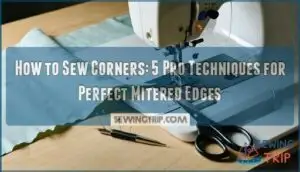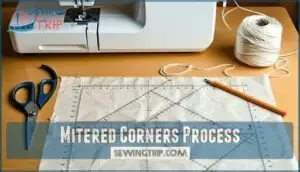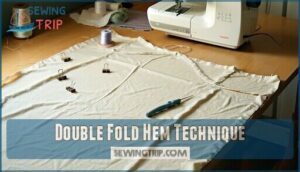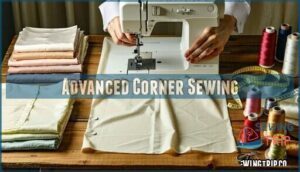This site is supported by our readers. We may earn a commission, at no cost to you, if you purchase through links.
 Learning how to sew corners properly starts with understanding your seam allowances and cutting fabric precisely.
Learning how to sew corners properly starts with understanding your seam allowances and cutting fabric precisely.
You’ll want to mark your pivot points before stitching—that’s where you’ll lift your needle, turn the fabric, and continue sewing. The key is keeping your needle down when pivoting to maintain clean lines.
For mitered corners, fold your fabric at a 45-degree angle and trim excess material before turning. Sharp scissors and a point turner make all the difference for crisp results.
Practice on scraps first since muscle memory beats theory every time. Master these basics and you’ll discover techniques that transform even simple projects into showstoppers.
Table Of Contents
Key Takeaways
- Mark your pivot points before stitching—you’ll lift your needle at these spots, turn the fabric, and continue sewing while keeping the needle down for clean lines.
- Choose the right fabric for sharp corners—cotton blends offer crisp lines without fuss, while smooth fabrics keep edges neater than heavy ones that’ll test your patience.
- Trim excess fabric at 45-degree angles, leaving a quarter-inch seam allowance to prevent bunching and create smooth corners.
- Practice on scraps first since muscle memory beats theory—you’ll build confidence and perfect your technique before working on important projects.
Sewing Corner Basics
You’ll need sharp tools, careful measuring, and the right fabric to get crisp corners every time.
If you’ve ever found your fabric bunching up in the corner, you’re definitely not alone, but you’ll fix that today.
Fabric Selection for Corners
Your fabric choice sets the stage for sharp corners.
Quality fabric choices create the foundation for perfectly sharp, professional corners every time.
Cotton blends are a steady favorite, offering crisp lines without too much fuss.
Pay attention to texture choices and weave patterns—smooth fabrics keep edges neat, while heavier ones may test your patience.
Match thread colors with care to blend in or stand out.
Here’s a sewing tip: picking the right fabric type means your corner techniques shine every time.
Understanding cotton fabric properties is essential for achieving professional results with crisp lines and the right fabric type.
Measuring and Cutting Fabric
Every crisp corner starts with smart Fabric Measurement.
Lay out your material, double-check the grain alignment, and use a ruler for precision cutting.
Cut slowly—don’t race the scissors.
Even one crooked line can throw off corner seams.
Remember, accurate Cutting Tools and patient hands make sewing corners a breeze.
Careful fabric layout sets you up for those sharp fabric corners and foolproof corner techniques every time.
Tools for Sewing Corners
With sewing corners, the right tools make all the difference.
A sturdy sewing machine is your best friend, but don’t overlook handy helpers like Corner Rulers and Seam Gauges for spot-on accuracy.
Fabric Cutters slice through edges like butter, while Thread Clippers offer tidy finishes.
For clean corners and sharp results, these are your MVPs.
Use these sewing tips and watch your corner finishing shine.
Mastering basic sewing supplies is essential for achieving professional-looking corners and overall sewing projects.
How to Sew Corners
Before you jump into sewing corners, a bit of Fabric Prep works wonders. Keep your seam allowance consistent and don’t skimp on Sewing Notions.
Know your Thread Choices for different Corner Styles—light for soft fabrics and heavier for crisp, clean corners. Nail these basics and you’ll stay in control, whether it’s mitered corners or tackling tricky 3D corners.
Understanding sewing corner basics is essential for achieving professional results.
- Double-check your measurements before cutting.
- Use pins or clips to keep edges lined up.
- Trim excess fabric for smoother corner finishing.
Corner Sewing Techniques
Mastering different corner techniques transforms your sewing from amateur to professional quality in just a few simple steps.
You’ll discover four essential methods that create sharp, clean edges whether you’re hemming curtains, making bags, or crafting quilts, which will help you achieve professional quality results.
Mitered Corners Process
Creating perfect mitered corners starts with fabric preparation and precise measuring.
Sharp corners start with sharp preparation—measure twice, cut once, sew perfectly.
Mark 2x your hem width from each corner edge, then draw diagonal guidelines for accurate sewing. Fold your fabric twice at ½-inch increments, pressing each fold for crisp guidelines.
This corner cutting technique eliminates bulk while ensuring professional corner finishing. Master these mitered tips for flawless sewing precision.
To achieve a professional finish, understanding sewing mitered corners is essential for garment construction.
Sewing Boxed Corners
Boxed corners transform flat fabric into three-dimensional shapes, perfect for bags and containers.
You’ll create precise square corners by folding fabric at right angles and securing with reinforcement stitches. This corner formation technique requires careful seam allowance management and fabric folding precision.
- Mark your corner points – Use fabric chalk to draw exact fold lines for consistent square corners
- Pin before stitching – Secure fabric layers to prevent shifting during corner reinforcement
- Test your seam allowance – Practice on scraps first to nail your sewing precision every time
Double Fold Hem Technique
Perfect mitered corners need proper preparation. You’ll create professional-looking hems by folding fabric edges twice, typically 0.25 to 0.5 inches each fold.
This double fold hem technique works best with cotton and linen fabrics on straight edges. To achieve a professional touch, understanding sewing mitered corners is essential for lasting results.
| Step | Fold Width | Hemming Tools |
|---|---|---|
| First Fold | 0.25-0.5 inch | Steam iron |
| Second Fold | Same width | Point turner |
| Final Press | Sharp crease | Fabric clips |
Start by pressing your first fold with wrong side up. Create fabric folds by folding again at the same measurement.
This sewing tutorial shows how proper seam allowance creates lasting results. Use these folded hem tips for consistent corner formation across your project.
Trimming and Finishing Corners
After mastering the double fold hem, corner trimming and edge finishing transform your work from amateur to professional.
Sharp fabric cutting and precise seam closure create the foundation for perfect corners.
- Corner trimming: Cut excess fabric at 45-degree angles, leaving ¼-inch seam allowance
- Edge finishing: Press seams open before trimming to prevent bulk and puckering
- Corner shaping: Use a point turner or chopstick to push out sharp, clean points
This garment finishing technique separates neat corners from messy ones in any sewing tutorial.
Sewing Corner Tips
You’ll master perfect corners once you understand these essential tips that separate amateur sewers from pros.
These techniques will transform your sewing from wobbly attempts into sharp, professional-looking corners that make your projects look store-bought.
Using Needle Plate Guides
Your sewing machine’s needle plate features built-in guides that’ll transform your corner sewing game. These handy markers help you maintain consistent seam allowances and achieve perfect corners every time.
Here’s how to use them effectively:
| Guide Settings | Purpose | Best For |
|---|---|---|
| ⅜" markings | Standard seam allowance | Quilting, garments |
| ¼" markings | Precision piecing | Patchwork, crafts |
| ⅝" markings | Heavy-duty sewing | Home décor, bags |
Position your fabric edge along the appropriate marking for sewing accuracy. The needle alignment stays consistent, giving you fabric control that makes neat corners automatic.
Proper needle plate maintenance is essential for achieving accurate seam allowances and preventing damage to the sewing machine, which is crucial for perfect corners and overall sewing machine performance.
Making Own Seam Guides
Creating your own seam guides transforms any sewing machine into a precision tool.
Simply position painter’s tape or a stack of Post-It Notes at your desired seam allowance distance from the needle.
These DIY sewing aids offer the same accuracy as commercial corner rulers while costing pennies.
Clean your machine surface first for maximum adhesion, then measure carefully using fabric marking techniques for consistent results.
Using proper sewing machine guides can greatly improve the overall sewing experience.
Marking and Sewing Corners
Before you start stitching, proper Corner Preparation sets you up for success.
Use fabric marking tools like chalk or washable markers to clearly mark your seam lines and corner points.
This simple step transforms guesswork into precision, giving you the Stitch Control needed for professional results.
Quality Sewing Notions make all the difference when marking fabric edges accurately.
Repeat on All Corners
Once you’ve nailed corner alignment and seam matching on your first corner, don’t stop there. Consistency across all corners separates amateur projects from professional-looking garments. Your muscle memory will kick in, making each subsequent corner easier than the last.
Here’s your corner-by-corner action plan:
- Match your fold techniques – Keep the same crease depth and angle measurement for uniform results
- Maintain stitch consistency – Use identical seam allowances and tension settings throughout
- Check edge finishing – Confirm each corner receives the same trimming and pressing treatment
- Verify right side out appearance – Flip and inspect each completed corner before moving forward
- Double-check that 45-degree angle – Use a quilting ruler to confirm sharp, clean mitered edges
Advanced Corner Sewing
You’ve mastered the basics, now it’s time to tackle complex corner challenges that’ll test your skills.
These advanced techniques handle tricky situations like bulky fabrics, multiple fabric layers, and three-dimensional corners that regular methods can’t handle, involving complete concepts.
Sewing 3-D Corners
When you’re ready to tackle dimensional sewing, 3-D corners transform flat fabric into structured shapes like bags and boxes.
This spatial construction technique requires precise fabric preparation and careful corner shaping.
You’ll sew three fabric pieces together at 90-degree angles, creating depth where flat meets form.
The key lies in accurate seam alignment and stopping exactly at marked intersection points for crisp results.
Attaching Third Piece of Fabric
Now you’ll position the third fabric piece with proper Fabric Alignment and Seam Allowance consistency.
Pin this piece perpendicular to your existing seam, maintaining even Fabric Tension throughout.
Your sewing guide becomes critical here – match raw edges precisely before stitching.
This fabric manipulation requires patience, but consistent Corner Reinforcement prevents puckering.
Keep Edge Finishing uniform across all three pieces for professional results in your sewing corners project.
Completing Corner and Finishing Project
Finishing your corner successfully means securing all seam edges with precise backstitch techniques.
Press seams flat, then trim excess fabric to reduce bulk.
Use edge stitching along the fabric binding to create clean project completion.
Hand stitch any loose threads for professional corner finishing.
Your sewing techniques determine whether corners look homemade or expertly crafted.
Mastering corner sewing techniques is essential for achieving crisp, professional finishes on various sewing projects, which requires precise techniques.
Quality and Accuracy Considerations
Quality matters when your corner sewing techniques meet professional standards.
Precision Sewing demands consistent seam allowances within 1/16 inch tolerance.
Check Corner Alignment by measuring angles—they should hit within 2° of perfect right angles.
Maintain steady Fabric Tension to prevent puckering.
Practice Stitch Control for even spacing at 2-3mm intervals.
Error Reduction comes through final inspection, catching defects in nearly 20% of corners before they become permanent problems.
Frequently Asked Questions (FAQs)
How do you sew a right angled corner?
Align fabric edges at 90 degrees, then stitch straight seams from corner point outward. Trim excess fabric, leaving quarter-inch seam allowance. Press seams open for crisp, professional-looking corners.
Is it difficult to sew a corner?
Sewing corners isn’t particularly difficult once you grasp the basic technique.
You’ll need patience for your first few attempts, but corners become routine with practice.
The key’s maintaining consistent seam allowances and taking your time.
Can you sew mitered corners?
Yes, you can sew mitered corners with practice.
Cut fabric at 45-degree angles, fold precisely, and stitch carefully.
They create sharp, professional-looking corners perfect for tablecloths, napkins, and curtains.
Start with simple projects first.
How to sew corners without bunching?
Trim excess fabric before turning corners, leaving just a quarter-inch seam allowance. Press seams open, then grade them by cutting different lengths to reduce bulk and create smooth, flat corners.
What tension settings work best for corner seams?
Like tuning a guitar string, tension settings need perfect balance for smooth corner seams.
Use medium tension (3-4 on most machines) to prevent puckering while maintaining secure stitches.
Test on fabric scraps first.
How do you prevent fabric bunching in corners?
Clip fabric at corner seam allowances before turning to reduce bulk.
Use sharp scissors to make diagonal cuts, stopping just short of stitching lines.
This prevents bunching while maintaining corner integrity.
Can you sew corners without a sewing machine?
Hand-sewing corners works perfectly without a machine.
Use a running stitch or backstitch for strength.
Pin fabric pieces together, stitch slowly around the corner, then trim excess seam allowance and turn right-side out for crisp results.
Whats the difference between French and Hong Kong corners?
Like comparing apples to oranges, French corners use clean diagonal folds while Hong Kong corners create neat bound edges with bias tape.
Giving you two distinct finishing techniques for professional results, French corners and Hong Kong corners provide different approaches to achieving a polished look.
How do you fix uneven or crooked corners?
You’ll need to carefully unpick the stitches around the wonky corner, then re-mark your seam allowances using a ruler.
Press the fabric flat, pin precisely, and stitch slowly for clean, even results.
Conclusion
Mastering how to sew corners transforms your projects from amateur to professional quality.
You’ve learned five essential techniques that’ll serve you throughout your sewing journey.
Start with basic pivoting, then progress to mitered edges as your confidence grows.
Remember to practice on scraps before tackling important pieces.
Sharp tools, precise measurements, and patience create perfect results every time.
These corner-sewing skills reveal endless possibilities for home décor, clothing, and craft projects that’ll impress everyone.
- https://blog.fabrics-store.com/2018/12/05/sewing-glossary-how-to-sew-mitered-corners-tutorial/
- https://www.lovenotions.com/how-to-sew-mitered-corners
- https://blog.joejuneandmae.com/perfect-mitered-corners-4-easy-ways/
- https://siemachtsewingblog.com/2022/03/how-to-sew-mitered-corners-of-unequal-lengths/
- https://charlottekan.com/blogs/sewingblog/mitered-corners-two-methods-and-when-to-use-them












